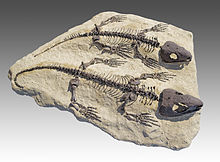Captorhinidae
| Captorhinids | |
|---|---|

| |
| Fossil Captorhinus specimens | |
| Scientific classification | |
| Domain: | Eukaryota |
| Kingdom: | Animalia |
| Phylum: | Chordata |
| Class: | Reptilia |
| Clade: | Eureptilia |
| Family: | †Captorhinidae Case, 1911
|
| Type species | |
| †Captorhinus aguti | |
| Genera | |
|
See text | |
| Synonyms | |
Captorhinidae is an extinct family of
Description

Captorhinids are a clade of small to very large lizard-like animals that date from the
Histological and SEM analysis of captorhinid tail vertebrae concluded in a 2018 study that captorhinids were the first amniotes to develop caudal autotomy as a defensive function. In studied specimens a split line is present in certain caudal vertebrae that is similar to those found in modern reptiles that perform caudal autonomy. This behaviour represented significant evolutionary benefit for the animals, allowing for escape and distracting predators, as well as minimizing blood loss at an injury site.[4]
Discovery and history

Captorhinidae contains a single subfamily, the Moradisaurinae. Moradisaurinae was named and assigned to the family Captorhinidae by A. D. Ricqlès and P. Taquet in 1982. Moradisaurinae was defined as "all captorhinids more closely related to Moradisaurus than to Captorhinus". The moradisaurines inhabited what is now China, Morocco, Niger, Russia, Texas and Oklahoma.[6]
Captorhinids were once thought to be the ancestors of
Classification
Taxonomy
The following taxonomy follows Reisz et al., 2011 and Sumida et al., 2010 unless otherwise noted.[6][7]
- Family Captorhinidae
- Captorhinoides?
- Acrodenta[11]
- Baeotherates[12]
- Captorhinus
- Euconcordia
- Labidosauriscus
- Opisthodontosaurus
- Protocaptorhinus
- Reiszorhinus
- Rhiodenticulatus
- Romeria
- Saurorictus
- Subfamily Moradisaurinae
- Dubious Captorhinids
- Puercosaurus
- Riabininus
- Chamasaurus
Phylogeny
The cladogram below follows the topology from a 2011 analysis by paleontologists Robert R. Reisz, Jun Liu, Jin-Ling Li and Johannes Müller.[6]
| |||||||||||||||||||
Simões et al. (2022) recovered captorhinids as stem-amniotes instead, as the sister group to
References
- .
- ^ Multiple tooth-rowed captorhinids from the early Permian fissure fills of the Bally Mountain Locality of Oklahoma
- PMID 28417061.
- PMID 29507301.
- ^ S2CID 20274349.
- ^ S2CID 31500853.
- ^ Watson, D.M.S. (1914). "Eunotosaurus africanus Seeley and the ancestors of the Chelonia". Proceedings of the Zoological Society of London. 11: 1011–1020.
- ^ "Facts About Turtles: Eunotosaurus And Turtle Evolution". All-About-Reptiles.com. Archived from the original on 12 September 2010. Retrieved 1 August 2010.
- PMID 26106865.
- ^ Nor-Eddine Jalil; Jean-Michel Dutuit (1996). "Permian captorhinid reptiles from the Argana formation, Morocco" (PDF). Palaeontology. 39 (4): 907–918. Archived from the original (PDF) on 2012-04-25.
- ^ W. J. May & Richard L. Cifelli (1998). "Baeotherates fortsillensis, A New Captorhinid Reptile from the Fort Sill Fissures, Lower Permian of Oklahoma". Oklahoma Geology Notes. 58: 128–137.
- ^ a b The Paleobiology Database: Moradisaurinae Archived 2011-10-04 at the Wayback Machine
- .
- .
- PMID 35984885.
- PMID 37733816.
